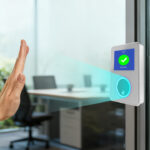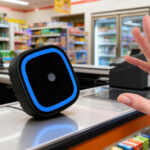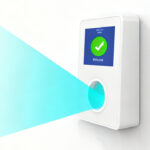How Palm Vein Recognition Works
Palm vein recognition uses near-infrared light to capture invisible vein structures inside the human hand. When the palm is placed above or near the sensor, hemoglobin absorbs the infrared light, creating a detailed map of the vascular pattern. The system then converts this into a biometric template and compares it with stored data for verification.
Because vein patterns are internal, stable, and impossible to observe with the naked eye, they provide stronger identity protection than surface-level biometrics such as fingerprints.
Key Features of Palm Vein Recognition
1. High Security with Anti-Spoofing Technology
Palm vein biometrics resist common spoofing attempts because vein patterns cannot be forged, copied, or lifted like fingerprints. This makes the technology ideal for high-security environments such as banking, laboratories, research centers, and restricted government zones.
2. Contactless and Hygienic Operation
Unlike fingerprint scanners, palm vein devices require no physical touch, reducing contamination risks and ensuring a safe and hygienic experience—especially important in hospitals, food processing plants, and public buildings.
3. Fast and User-Friendly Authentication
Modern palm vein recognition systems offer quick scanning speeds, allowing users to authenticate within seconds. This enhances efficiency in high-traffic access points such as office entrances, school gates, and factory time attendance systems.
4. Stable and Accurate Identification
Vein patterns remain consistent throughout a person’s lifetime and are less affected by external factors like sweat, dirt, water, or skin damage. This ensures highly reliable performance in challenging environments.
5. Integration with Multi-Biometric Systems
Palm vein recognition can be combined with face recognition, fingerprint scanning, RFID/NFC cards, and QR codes for flexible multi-factor authentication. Many modern AI access control devices support hybrid verification for greater security.
Applications of Palm Vein Recognition
Palm vein technology is now used across industries requiring fast, safe, and precise identity verification:
Corporate Offices – For employee access control and time attendance
Hospitals and Clinics – Touchless and hygienic entry for medical staff
Factories and Industrial Zones – Stable identification despite rough or dirty hands
Government and Border Control – Enhanced security for restricted areas
Schools and Universities – Contactless student attendance tracking
Banks and Financial Institutions – High-level authentication for vaults and secure areas
Smart Buildings and IoT Systems – Integrated access for intelligent facilities
Advantages of Palm Vein Recognition
Enhanced Safety for Public Use
Because the technology is fully contactless, it reduces physical touchpoints and helps prevent disease transmission in crowded areas.
Ideal for High-Security Requirements
Internal biological traits provide a level of security superior to fingerprints or facial features.
Works Even in Challenging Conditions
Palm vein scanning is unaffected by water, moisture, dust, or worn skin, making it ideal for industrial settings.
Highly Scalable for Modern Access Systems
It integrates easily into smart turnstiles, speed gates, attendance machines, and building access networks, supporting large organizations and complex access hierarchies.
Заключение
Распознавание вен ладони is redefining modern access control with its combination of contactless authentication, unmatched security, and high accuracy. As businesses and institutions continue transitioning toward smarter, safer, and more efficient identity verification systems, palm vein technology stands out as a powerful solution for workplaces, healthcare facilities, financial institutions, and high-security environments. Its ability to integrate with multi-biometric devices and smart building systems ensures long-term adaptability and reliability.
Связаться с нами
We would love to speak with you.
Feel free to reach out using the below details.





